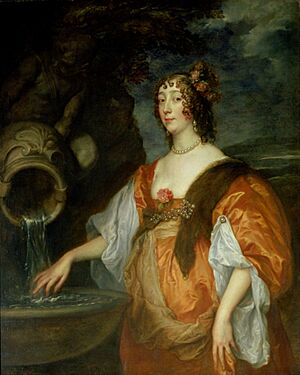Lucy Hay, Countess of Carlisle facts for kids

Lucy Hay, Countess of Carlisle (born Percy; 1599 – 5 November 1660) was an English courtier. She was known for her beauty and cleverness. She played a part in many political events during the English Civil War.
Contents
Who Was Lucy Hay?
Lucy Hay was born Lady Lucy Percy in 1599. Her father was Henry Percy, 9th Earl of Northumberland, known as the "Wizard Earl." Her mother was Dorothy Percy, Countess of Northumberland. In 1617, she married James Hay, 1st Earl of Carlisle. Many poets of her time wrote about her charm. These included Thomas Carew, William Cartwright, Robert Herrick, and Sir John Suckling.
Life at Court
In 1626, Lucy became a Lady of the Bedchamber to Queen Henrietta Maria. She quickly became a favorite of the Queen. Lucy even took part in two of the Queen's famous masque plays. These were special performances with music, dance, and costumes.
Lucy was a very important person at the court of King Charles I. She became involved in the politics of the time. She shared information with different political leaders. For example, she was close to Thomas Wentworth, 1st Earl of Strafford. After his death in 1641, she began to support John Pym and the Parliament's leaders. She shared the King's secret plans with them.
A Woman of Influence
One of her most important actions happened in 1642. She warned her cousin, Robert Devereux, 3rd Earl of Essex, about the King's plan. The King wanted to arrest five members of the Long Parliament. Because of Lucy's warning, Essex and the others were able to escape.
However, it seems she also shared information with both sides. This sometimes made political disagreements even worse.
Imprisonment and Later Life
In 1647, Lucy started supporting the moderate Presbyterian party. This group often met at her house. During the Second Civil War, she actively helped the royalist cause. She even sold her pearl necklace for £1500 to raise money for Lord Holland's soldiers. She also communicated with Prince Charles while he was blocking the Thames river. She helped connect royalist groups with the Queen.
Because of her actions, she was arrested on 21 March 1649. She was sent to the Tower of London. While there, she used a secret code to write to the King through her brother, Lord Percy. This continued until Charles went to Scotland. She was released on bail on 25 September 1650. After this, she did not have as much influence with the royalists. She died shortly after the Restoration of the monarchy.
Lucy died suddenly on 5 November 1660. She had eaten well at lunchtime. But around 2 PM, she suddenly became sick while cutting a ribbon. She passed away by 5 or 6 PM that same day.
Lucy Hay in Stories
François de La Rochefoucauld wrote about an interesting story in his Memoirs. He heard that Lucy Hay once took some diamond studs from George Villiers, 1st Duke of Buckingham. These studs were a gift from the King of France to Anne of Austria. The King of France later wanted to see the studs. The Queen was somehow able to get them back.
Alexandre Dumas later used this entire story in his 1844 novel The Three Musketeers. It is believed that he based the character of Milady de Winter on Lucy Carlisle.
Sources
- Betcherman, Rose (2005). Court Lady and Country Wife: Two Noble Sisters in Seventeenth-Century England. New York: HarperCollins.
- "Carlisle, Lucy Hay, countess of." Encyclopædia Britannica. 2005.
- Discussion of Upon My Lady Carlisle's Walking in Hampton Court Gardens by Sir John Suckling (Guardian.co.uk, 2011)


